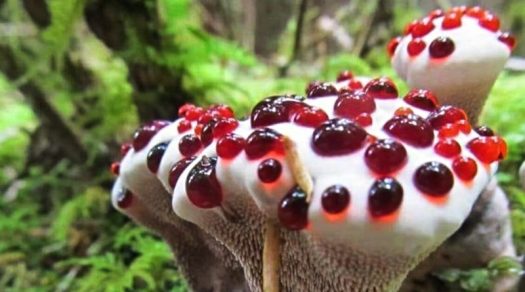
Love Lies Bleeding‘s readers know that main character Mara is both a vampire and a botanist. Trained when she was still human, she continues to study plants and have a garden. This post is tenth in a series exploring Mara’s plants. Are you interested in botany, gardening, or plant lore? So are some vampires…
Please note: Medicinal uses are given for informational purposes only. Always consult a medical professional before diagnosing or treating yourself or anyone else.
Botanical Name: Hydnellum peckii
Common Names: strawberries and cream, bleeding Hydnellum, bleeding fungus, red-juice tooth, devil’s tooth, Peck’s hydnum, bile tooth
History: Found mainly in North America and Europe, bleeding tooth fungus forms mutually beneficial relationships with mature coniferous trees. Its spores are “on the surface of vertical spines or tooth-like projections that hang from the undersurface of the fruit bodies” (1). As the fungus ages, it dries out, losing its bloody appearance and becoming a nondescript shade of brown or black. Bleeding tooth fungus bioaccumulates the heavy metal caesium. Although documented by humans for only about a hundred years, bleeding tooth fungus’s roots (no pun intended) go back hundreds of millions of years.
Language of Flowers Meaning: None
Cultivation: It prefers to grow in mature forested alpine and sub-alpine regions, so cultivating it isn’t really an option.
Uses:
Medicinal: Although scientists aren’t sure what the red substance that oozes out of bleeding tooth fungus is exactly, they have found that it contains a pigment with anticoagulant and antibacterial properties. It also contains another substance that may be beneficial in treating Alzheimer’s disease. It is currently undergoing trials to determine its potential medical uses.
Culinary: It’s technically edible (in that it isn’t poisonous), with a peppery and strongly bitter taste that doesn’t go away even when dried. While it can be eaten, whether anyone actually wants to eat it is another matter.
Dye: The dried fungus produces a beige or tan dye. It can also be combined with iron or alum for shades of blue and green.
Mara’s Uses: Mara mentions it in Love Lies Bleeding as a potentially useful plant she needs to learn more about.
(1) https://en.wikipedia.org/wiki/Hydnellum_peckii
Further Reading

Love Lies Bleeding: Smashwords, Barnes & Noble, Kobo, Apple Books
FREE Blood Magic: Smashwords, Barnes & Noble, Kobo, Apple Books
FREE Tooth & Claw: Smashwords, Barnes & Noble, Kobo, Apple Books
If you prefer a good paperback to an ebook, use this link to order Love Lies Bleeding from Bookshop – a portion of each sale goes directly to independent bookstores, as well as to myself. Thank you for supporting indie! ♥
This bizarre B.C. mushroom looks like a tooth oozing thick red blood
What is bleeding tooth fungus?
The Bleeding Tooth Fungus (Hydnellum peckii)
Hydnellum peckii: The Ultimate Mushroom Guide
Cheers,
Aspasía S. Bissas
[Originally posted on my official site: AspasiaSBissas.com]

No comments:
Post a Comment